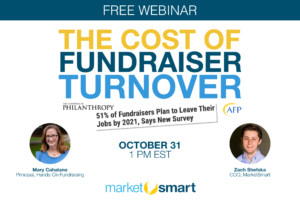We use cookies to ensure that we give you the best experience on our website. By continuing to use this site, you agree to our use of cookies in accordance with our Privacy Policy.
 Login
Login
Your Role
Challenges You Face
results
Learn
Resources
Company
How Important Is Training for Fundraisers? Very.


This time of year is filled with tricks and treats. The end of October seemingly always has something in store for us, whether it be a new costume fad, wacky weather (too hot, or too cold), or the general “all hands on deck” push to execute year-end fundraising strategies. October is a month full of ups and downs, preceding the most important (and busiest) fundraising period of year.
What better time than now to discuss the key individuals who power nonprofits through this enduring stretch? A slew of recent research (most notably the AFP, Chronicle of Philanthropy, and Harris Insights & Analytics collaboration yielding a long-form article entitled “Why Fundraisers Leave, and How to Keep Them”), and past reports (for instance the Mastering Major Gifts report, or the 2013 report from CompassPoint and the Evelyn and Walter Haas, Jr. Fund titled “Underdeveloped”) provide great insight into the challenges, struggles, and hurdles development professionals face in their day-to-day lives.
I’ve been re-reading these reports over the past few weeks in advance of a webinar I am hosting on Halloween day with Mary Cahalane. Click here to register or receive the recording. Mary and I plan to discuss the recent AFP, Chronicle, Harris Insights & Analytics results and what implications they have on developments shops. In preparing for that presentation I couldn’t help but find myself connecting dots that previously had been disparate.
One of the most noteworthy connections was between the recent research from Harris Insights & Analytics and Dr. Rita Kottasz, Dr. Adrian Sargeant, and Amy Eisenstein’s Mastering Major Gifts report. It’s important to recognize that both research reports stem from convenience samples (ie survey respondents), however their size and scope (1,035 fundraisers in the United States and Canada for Harris, and 662 fundraisers from organizations that generated income of under $10 million for the other) represent large enough sample sizes to begin theorizing “why” their results played out the way they did.
The Harris research presents two startling facts about training at nonprofits:
- 61% of people who left fundraising jobs say they were dissatisfied with their access to leadership training.
- 34% of current fundraisers are dissatisfied with their access to leadership training.
Juxtapose this with one of the most eye-opening findings from the other research report:
“Our interviewees had highlighted that they felt that learning was an important issue and our quantitative results certainly seem to support that. It is striking that engaging in one additional form of training is associated with an increase in revenue of $37,000.”
The report goes on to say:
As a caveat, we must be careful here not to imply causality, because it may be that only the better fundraisers are drawn to education and development, but there certainly seems a prima facia case here for greater investment in the development of key personnel. Anecdotally, too many boards of particularly smaller nonprofits worry about the risk of investing in someone who then subsequently decides to leave. Our results suggest that they may do better to worry about the risk of not investing in someone who subsequently decides to stay.
What more needs to be said? Although the report authors make it clear that we “cannot imply causality,” we can at least propose a hypothesis: investing in professional development and training is a win-win. Not only will front-line fundraisers be more satisfied with their job (and potentially less likely to leave), they will also be more effective and “profitable” for their organization.
This isn’t the only insight I’ve uncovered! If you’re interested in learning more, consider joining us for our free webinar. Click here to register.
Get smarter with the SmartIdeas blog
Subscribe to our blog today and get actionable fundraising ideas delivered straight to your inbox!


Definitely sharing this. With budget shortages, training is so often overlooked in the nonprofit industry.
Jason, you’re spot on. Thanks for reading and sharing. It may be a tough pill to swallow for those in leadership positions, but the reality is (at least it seems), that the more you invest in your people, the better they’ll perform, and the less likely they’ll be to leave. Overlooked? Yes. Worthy of deeper discussion at your nonprofit? Most likely.
[…] comments, or via email if you like – about your own thoughts or experiences. You can also read Zach’s take on it […]